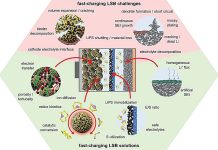
Solar energy is a key player in the shift towards renewable energy, and researchers are constantly on the lookout for better materials to make solar panels more efficient.
While silicon-based solar panels have been the go-to choice due to their high efficiency, they have some downsides: they’re heavy, rigid, and not the easiest to recycle.
That’s where Dr. Christoph Brabec and his team at the Helmholtz Institute Erlangen-Nürnberg (HI ERN) and FAU are making waves.
They’re focusing on a different kind of solar technology called organic photovoltaics (OPV). This innovative approach might just change how we harness the sun’s power.
What’s Special About OPV?
OPV’s biggest draw is its flexibility and transparency. Imagine solar panels that could blend into windows, façades, or even be used as roofing for greenhouses.
They’re not just versatile; they’re also better for the environment. The materials are more eco-friendly to produce and easier to recycle than traditional silicon panels.
Breaking Efficiency Records
For a long time, OPV lagged behind silicon panels in terms of how well they converted sunlight into electricity.
Just a few years back, OPV panels were struggling to reach efficiencies of 10%. But Dr. Brabec’s team has set a new record: their organic solar module has reached an efficiency of 14.46%.
The team’s success came down to three key improvements:
- Better Materials: They started by using higher quality active materials for the solar panels.
- Reducing Inactive Areas: Dr. Andreas Distler, a key member of the team, focused on minimizing the areas of the module that don’t produce electricity. They achieved this by refining the laser structuring process, which carves the module surface into individual solar cells. The goal was to make these laser lines as thin as possible.
- Improving Coating: Lastly, in collaboration with Georg Simon Ohm TH Nürnberg, the team developed a more uniform coating method. This might seem like a small change, but it boosted efficiency by a whole percentage point.
This world record isn’t just a number; it represents a significant stride in making solar energy more accessible and sustainable.
The collaboration between FAU, HI ERN, and Forschungszentrum Jülich, as part of the Solar Factory of the Future at Energie Campus Nürnberg, showcases the potential for organic solar technology to play a crucial role in the energy transition.
This breakthrough is more than just a technical achievement. It’s a step towards a future where solar energy is not confined to large solar farms in remote areas.
Instead, it can be integrated seamlessly into our everyday surroundings, from the windows of our homes to the roofs of our workplaces.
With this advancement, we’re getting closer to a world where renewable energy is the norm, and solar power is a key player in our energy mix.
In essence, Dr. Brabec’s team is leading the way in making solar energy more versatile, environmentally friendly, and efficient – a true game-changer in the quest for sustainable energy solutions.
Source: KSR.



